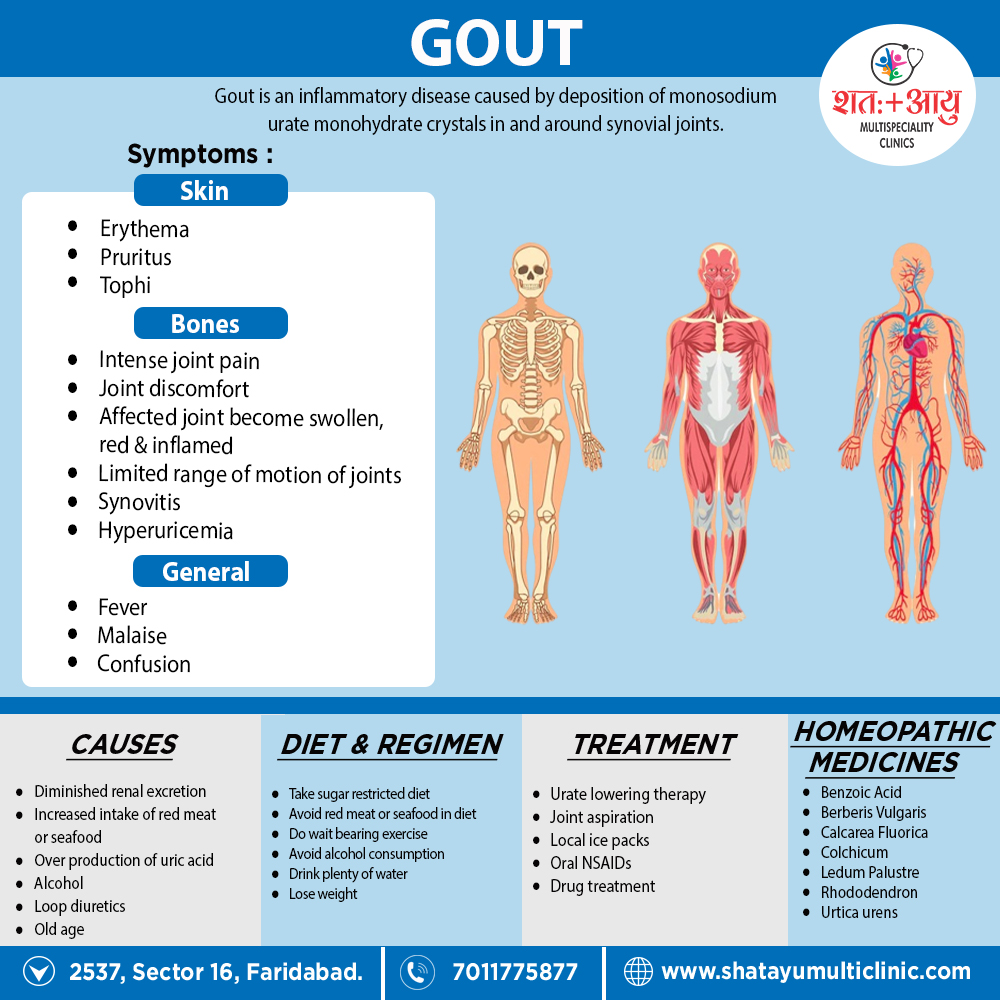The signs and symptoms of gout almost always occur suddenly, and often at night. They include:
Intense joint pain:
- Gout usually affects the large joint of your big toe, but it can occur in any joint.
- Other commonly affected joints include the ankles, knees, elbows, wrists also fingers.
- The pain is likely to be most severe within the first four to 12 hours after it begins.
Lingering discomfort:
- After the most severe pain subsides, some joint discomfort may last from a few days to a few weeks.
- Later attacks are likely to last longer and affect more joints.
Inflammation and redness:
- The affected joint or joints become swollen, tender, warm also red.
Limited range of motion:
- As gout progresses, you may not be able to move your joints normally. [2]
- The classical presentation is with an acute monoarthritis, which in over 50% of cases affects the first MTP joint.
Other common sites are;
- Ankle
- Midfoot
- Knee
- Small joints of hands
- Wrist
- Elbow
- The axial skeleton and large proximal joints are rarely involved.
Typical features include:
- Rapid onset
- Reaching maximum severity in 2–6 hours,
- Often waking the patient in the early morning
- Severe pain
- Often described as the ‘worst pain ever’
- Extreme tenderness, such that the patient is unable to wear a sock or to let bedding rest on the joint
- Marked swelling with overlying red, shiny skin
- Self limiting over 5–14 days, with complete resolution
During the attack, the joint shows signs of;
- Marked synovitis
- Swelling
- Erythema
There may be accompanying;
- Fever
- Malaise and even confusion
- Especially if a large joint such as the knee is involved.
As the attack subsides;
- Pruritus and desquamation of overlying skin are common.
The main differential diagnosis is septic arthritis, infective cellulitis or reactive arthritis.
Acute attacks may also manifest as bursitis, tenosynovitis or cellulitis, which have the same clinical characteristics.
Many patients describe milder episodes lasting just a few days.
Some have attacks in more than one joint.
Others have further attacks in other joints a few days later (cluster attacks), the first possibly acting as a trigger.
Simultaneous polyarticular attacks are unusual.
In others, several years may elapse before the next attack.
In many, however, a second attack occurs within 1 year and may progress to chronic gout, with chronic pain and joint damage, and occasionally severe deformity and functional impairment.
Patients with uncontrolled hyperuricemia who suffer multiple attacks of acute gout may also progress to chronic gout.
Urate Crystals
Crystals may be deposited in the joints and soft tissues to produce irregular firm nodules called tophi.
These have a predilection for the extensor surfaces of fingers, hands, forearm, elbows, Achilles tendons and sometimes the helix of the ear.
Characteristics of Tophi
Tophi have a white colour, differentiating them from rheumatoid nodules.
Tophi can ulcerate, discharging white gritty material, become infected or induce a local inflammatory response, with erythema and pus in the absence of secondary infection.
They are usually a feature of longstanding gout but can sometimes develop within 12 months in patients with chronic renal failure.
Occasionally, tophi may develop in the absence of previous acute attacks, especially in patients on thiazide therapy who have coexisting OA.
In addition to causing musculoskeletal disease, chronic hyperuricemia may be complicated by renal stone formation and, if severe, renal impairment due to the development of interstitial nephritis as the result of urate deposition in the kidney.
This is particularly common in patients with chronic tophaceous gout who are on diuretic therapy. [1]

